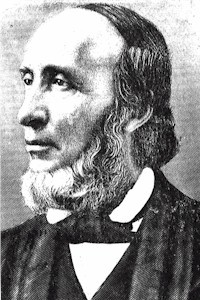

This article needs additional citations for verification. Please help improve this articlebyadding citations to reliable sources. Unsourced material may be challenged and removed.
Find sources: "Edmund Sears" – news · newspapers · books · scholar · JSTOR (April 2015) (Learn how and when to remove this message) |

Edmund Hamilton Sears (April 6, 1810 – January 14, 1876) was an American Unitarian parish minister and author who wrote a number of theological works influencing 19th-century liberal Protestants. Today, Sears is primarily known as the man who penned the words to "It Came Upon the Midnight Clear" in 1849. It has been sung to two tunes, one by Richard Storrs Willis and another adapted by Arthur Sullivan from a traditional English air.
Sears originally wrote the song as a melancholy reflection on his times while a minister in Wayland, Massachusetts, US. However, "It Came Upon the Midnight Clear" has since become a popular Christmas carol.
Born on April 6, 1810, the youngest of three sons of Joseph and Lucy (Smith) Sears, Edmund grew up on a farm within sight of the Berkshire Hills, in Sandisfield, Massachusetts.[1] Sears attended Union College, in Schenectady, New York, where he was a member of the Delta Phi fraternity. Following graduation from Union in 1834, Sears studied law for nine months under a lawyer in Sandisfield. He attended Harvard Divinity School, graduating in 1837 and began to preach as a missionary in Toledo, Ohio, remaining nearly a year. He served the Greater Boston Unitarian congregation in Wayland, and then a larger congregation in Lancaster. After seven years of hard work, he suffered a breakdown and returned to Wayland. He wrote "It Came Upon the Midnight Clear" while serving as a part-time preacher in Wayland.[2]
In addition to the above noted hymn, Sears authored the following publications: Fire-side Colloquies (1847); Regeneration (1853); Calm on the Listening Ear of Night; Pictures of the Olden Time (1857); Athanasia (1858); and Sermons and Songs of the Christian Life (1875). With Rev. R. Ellis he edited The Monthly Religious Magazine for twelve years.[3]
Sears found Christ best presented in the Gospel of John. The Fourth Gospel the Heart of Christ (1872) was his most widely read work.[1]
Sears preached the equality of women and men. After the Fugitive Slave Law was passed, Sears declared from his pulpit that "when the human and the Divine law were in conflict it was the duty of all to obey the latter."[1] On Sunday, June 16, 1856, Sears delivered a sermon entitled "Discourse" which not only condemned chattel slavery as evil, but also the slaveholders whom he called the "slave power". The sermon was deemed to be such a strong argument against slavery that it was published and circulated as a pamphlet by Massachusetts abolitionists. "When wrong has become so organized as to make the state its permanent body", said Sears, then the state's functions and the men holding offices do the bidding of wrong and of evil. Sears continued, "humanity dies out of it [the state], and demonism becomes its life and soul".[citation needed]
He died January 14, 1876, in Weston, Massachusetts.[4]
| International |
|
|---|---|
| National |
|
| Artists |
|
| Other |
|